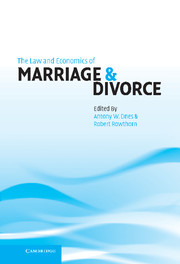Book contents
- Frontmatter
- Contents
- List of tables and figure
- List of contributors
- 1 Introduction
- 2 Marriage: the long-term contract
- 3 Marital commitment and the legal regulation of divorce
- 4 Mutual consent divorce
- 5 An economic approach to adultery law
- 6 Louisiana's covenant marriage law: recapturing the meaning of marriage for the sake of the children
- 7 Cohabitation and marriage
- 8 Marriage as a signal
- 9 For better or for worse? Is bargaining in marriage and divorce efficient?
- 10 Weak men and disorderly women: divorce and the division of labor
- 11 The impact of legal reforms on marriage and divorce
- 12 European divorce laws, divorce rates, and their consequences
- Index
- References
6 - Louisiana's covenant marriage law: recapturing the meaning of marriage for the sake of the children
Published online by Cambridge University Press: 13 August 2009
- Frontmatter
- Contents
- List of tables and figure
- List of contributors
- 1 Introduction
- 2 Marriage: the long-term contract
- 3 Marital commitment and the legal regulation of divorce
- 4 Mutual consent divorce
- 5 An economic approach to adultery law
- 6 Louisiana's covenant marriage law: recapturing the meaning of marriage for the sake of the children
- 7 Cohabitation and marriage
- 8 Marriage as a signal
- 9 For better or for worse? Is bargaining in marriage and divorce efficient?
- 10 Weak men and disorderly women: divorce and the division of labor
- 11 The impact of legal reforms on marriage and divorce
- 12 European divorce laws, divorce rates, and their consequences
- Index
- References
Summary
Though American divorce law was never intended in principle to be as unusual as it has turned out in fact, it nevertheless carries a powerful ideology, sending out distinctive messages about commitment, responsibility, and dependency. … The American story about marriage, as told in the law and in much popular literature, goes something like this: marriage is a relationship that exists primarily for the fulfillment of the individual spouses. If it ceases to perform this function, no one is to blame and either spouse may terminate it at will.
(Glendon, 1987, pp. 106, 108)Introduction
The described redefinition of marriage “did not take place overnight in Western nations” (Glendon, 1987, p. 65). The process of change began well before the 1960s and 1970s, when “no-fault” divorce was generally adopted in the United States and other Western countries. In fact, divorce legislation in developed countries has proceeded for the past two hundred years in one general direction: it has become easier and easier for dissatisfied spouses to escape the marital relationship and, consequently, their familial responsibilities.
What has happened to alter so radically the American conception of marriage? Unquestionably, powerful social, economic, and cultural forces have been at work, eroding traditional notions of moral responsibility, and changes in the law have reflected such trends. The ideology of “no-fault” divorce conforms to fashionable theories that abhor objective value judgments and promotes an obsessive concentration on each individual's subjective self-fulfillment (Kramer, 1997; see also Glendon, 1987, p. 119; Gallagher, 1996, p. 265; Whitehead, 1997, p. 194).
- Type
- Chapter
- Information
- The Law and Economics of Marriage and Divorce , pp. 92 - 117Publisher: Cambridge University PressPrint publication year: 2002
References
- 4
- Cited by



